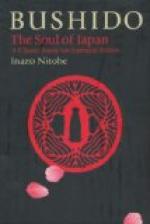[Footnote 28: Cerasus pseudo-cerasus, Lindley.]
The Yamato spirit is not a tame, tender plant, but a wild—in the sense of natural—growth; it is indigenous to the soil; its accidental qualities it may share with the flowers of other lands, but in its essence it remains the original, spontaneous outgrowth of our clime. But its nativity is not its sole claim to our affection. The refinement and grace of its beauty appeal to our aesthetic sense as no other flower can. We cannot share the admiration of the Europeans for their roses, which lack the simplicity of our flower. Then, too, the thorns that are hidden beneath the sweetness of the rose, the tenacity with which she clings to life, as though loth or afraid to die rather than drop untimely, preferring to rot on her stem; her showy colors and heavy odors—all these are traits so unlike our flower, which carries no dagger or poison under its beauty, which is ever ready to depart life at the call of nature, whose colors are never gorgeous, and whose light fragrance never palls. Beauty of color and of form is limited in its showing; it is a fixed quality of existence, whereas fragrance is volatile, ethereal as the breathing of life. So in all religious ceremonies frankincense and myrrh play a prominent part. There is something spirituelle in redolence. When the delicious perfume of the sakura quickens the morning air, as the sun in its course rises to illumine first the isles of the Far East, few sensations are more serenely exhilarating than to inhale, as it were, the very breath of beauteous day.
When the Creator himself is pictured as making new resolutions in his heart upon smelling a sweet savor (Gen. VIII, 21), is it any wonder that the sweet-smelling season of the cherry blossom should call forth the whole nation from their little habitations? Blame them not, if for a time their limbs forget their toil and moil and their hearts their pangs and sorrows. Their brief pleasure ended, they return to their daily tasks with new strength and new resolutions. Thus in ways more than one is the sakura the flower of the nation.
Is, then, this flower, so sweet and evanescent, blown whithersoever the wind listeth, and, shedding a puff of perfume, ready to vanish forever, is this flower the type of the Yamato spirit? Is the Soul of Japan so frailly mortal?
IS BUSHIDO STILL ALIVE?
Or has Western civilization, in its march through the land, already wiped out every trace of its ancient discipline?
It were a sad thing if a nation’s soul could die so fast. That were a poor soul that could succumb so easily to extraneous influences. The aggregate of psychological elements which constitute a national character, is as tenacious as the “irreducible elements of species, of the fins of fish, of the beak of the bird, of the tooth of the carnivorous animal.” In his recent book, full of shallow asseverations




